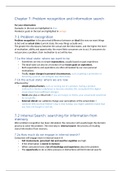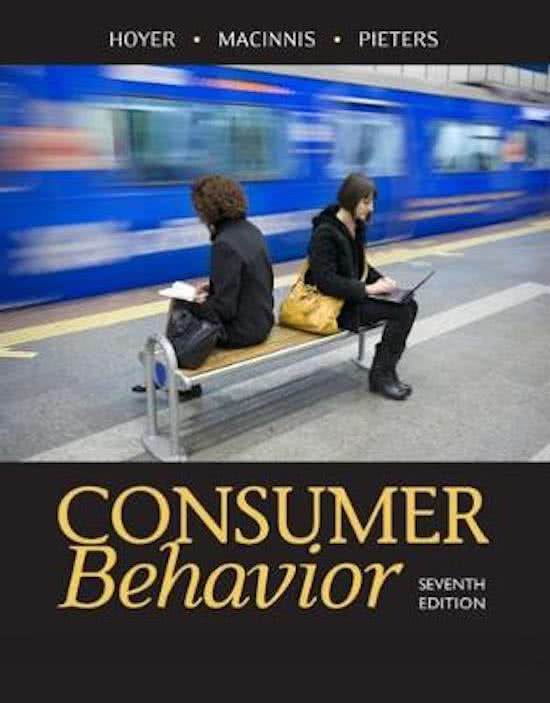Chapter 7: Problem recognition and information search
For your information:
Examples in the text are highlighted in blue.
Marketers goals in the text are highlighted in orange
7.1 Problem recognition
Problem recognition is the perceived difference between an ideal (the way we want things
to be) and an actual state (current state; the way things actually are).
The greater the discrepancy between the actual and the ideal states, and the higher the level
of motivation, ability and opportunity, the more likely consumers are to act. If consumers do
not perceive a problem, their motivation to act will be low.
7.1a the ideal state: where we want to be
- Sometimes we rely on simple expectations, usually based on past experience.
- The ideal state can also be a function of our future goals or aspirations.
- Both expectations and aspirations are often stimulated by our own personal
motivations.
- Finally, major changes in personal circumstances, such as getting a promotion or
becoming a parent, can instigate new ideal states
7.1b the actual state: where we are now.
Influenced by:
- simple physical factors, such as running out of a product, having a product
malfunction (broken cellphone) or become obsolete (NL: verouderd) (the digital
music player has insufficient storage).
- Needs also play a critical role: if you are hungry or thirsty, your actual state would not
be acceptable.
- External stimuli can suddenly change your perceptions of the actual state: if
someone tells you that Mother’s Day is next Sunday, you might suddenly realize that
you have not bought a card yet.
7.2 Internal Search: searching for information from
memory
After problem recognition has been stimulated, the consumer will usually begin the decision
process to solve the problem. The next step is: internal search: the process of recalling
stored information from memory.
7.2a How much do we engage in internal search?
Consumers will engage more in internal search if:
- Felt involvement, perceived risk and need for cognition are high
- If the information is stored in memory
- When consumers have a lot of knowledge and experience about the problem
- The opportunity to do so (time pressure or distractions will limit internal search)
,7.2b What kind of information is retrieved from internal search?
Recall of brands
Rather than remembering all available brands in any given situation, consumers tend to
recall a subset of two to eight brands known as a consideration or evoked set. In general,
the consideration set consists of brands that are top of mind or easy to remember.
Consideration sets vary in terms of their size, stability, variety and preference dispersion,
which is the equality of preferences towards brands or products in the set.
According to research, brands that are recalled are more likely to be chosen. However, a
brand’s simply being recalled does not guarantee that it will be in a consumer’s consideration
set because consumers can recall a number of brands and then reject undesirable
alternatives.
Researchers have looked at the following factors that increase the possibility of consumers’
recalling a particular brand during internal search, and including that brand in their
consideration set:
- Prototypicality: brands that are closest to the prototype or that most resemble other
category members are more easily to recall. For example: Apple’s iPad created the
category of tablet computer, which it still dominates.
- Brand familiarity: well-known brands are more easily recalled during internal search
than unfamiliar brands because the memory links associated with these brands tend
to be stronger. This explains why global brands have high familiarity worldwide and
are likely to be in many consumers considerations sets.
- Goals and usage situations: consumers have goal-derived and usage-specific
categories in memory, such as drinks to bring an après-ski party. The activation of
these categories will determine which brands they recall during internal search.
Therefore, marketers an attempt to associate products with certain goals and usage
situations.
- Brand preference: brands toward which the consumer has positive attitudes tend to
be recalled more easily and tend to be included in the consideration set more often.
This tendency highlights the importance of developing positive brand attitudes.
- Retrieval cues: By strongly associating the brand with a retrieval cue, marketers can
increase the chance that the brand will be included in the consumer’s consideration
set. Packaging for example, can also be an important retrieval cue for food products.
Therefore, Coca-Cola’s iconic glass bottle is still featured in some promotions.
Recall of attributes
Consumers can often recall some details when they engage in internal search, and the
recalled attribute information can influence their brand choices. The variables which
influence this recall are:
- Accessibility or availability: information that is more accessible or available – having
the strongest associative links- is the most likely to be recalled and entered into the
decision process. Marketers can make information more accessible by repeatedly
drawing attention to it in communications or by making the information more
relevant.
- Diagnosticity: diagnostic information helps us distinguish objects from one another.
For example: if all brands of computers have the same price, then the price is not
diagnostic or useful when consumers are making a decision. Research shows that
, negative information tends to be more diagnostic than positive or neutral information
because the former is more distinctive.
- Salience: research has clearly shown that consumers can recall very salient
(prominent) attributes even when their opportunity to process is low. By repeatedly
calling attention to an attribute in marketing messages, marketers can increase a
product’s salience and its impact on the decision. For information to be recalled and
entered into the decision, it must have attribute determinance, which means the
information is both salient and diagnostic.
- Vividness: vivid information (a photo of an arm wearing an Apple Watch) is presented
as concrete words, pictures, or instructions to imagine. Vivid information is easier to
recall than less dramatic information, but it only tends to influence judgment and
decision making when consumers have not formed a strong prior evaluation,
especially one that is negative.
- Goals: The consumer’s goals will determine which attribute is recalled from memory.
Recall of evaluations
We find overall evaluations or attitudes easier to remember than specific attribute
information. In addition, our evaluations tend to form strong associative links with the brand.
Evaluations are also more likely to be recalled by consumers who are actively evaluating the
brand when they are exposed to relevant information.
Recall of experiences
Experiences that are more vivid, salient, or frequent are the most likely to be recalled. Ads
may affect how accurately consumers can recall their product experiences, but their recall of
product’s evaluations is not necessarily affected.
Is internal search always accurate?
No, there are internal search biases:
Confirmation bias
Refers to our tendency to recall information that reinforces or confirms our overall beliefs
rather than contradicting them, thereby making our judgment or decision more positive than
it should be. When the confirmation bias is operating, we are more likely to recall positive
rather than negative information about favored brands.
Inhibition (NL: remming)
All the variables that influence the recall of certain attributes, such as accessibility, vividness,
and salience, can actually lead to the inhibition of recall for other diagnostic attributes. In
buying a house, for example, a consumer might recall information such as the selling price,
number of bathrooms, but may not recall other important attributes such as the size of the
lot.
Mood
Search are most likely to recall information, feelings, and experiences that match their mood.






